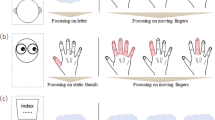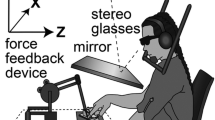Abstract
Active touch is often described as yielding “better-quality” information than passive touch. However, some authors have argued that passive-guided movements generate superior percepts due to a reduction in demands on the haptic sensory system. We consider the possibility that passive-guided conditions, as used in most active-passive comparisons, are relatively free from cognitive decision-making, while active conditions involve cognitive loads that are quite high and uncharacteristic of normal sensory processes. Thus studies that purport to show differences in active and passive touch may instead be revealing differences in the amount of cognition involved in active and passive tasks. We hypothesized that passive-guided conditions reduce not the sensory load but the cognitive load that active explorers must bear. To test this hypothesis Blood Oxygen Level Dependent (BOLD) activity was measured using functional Magnetic Resonance Imaging (fMRI) during active and passive-guided fingertip exploration of 2D raised line drawings. Active movements resulted in greater activation (compared with passive movements) in areas implicated in higher order processes such as monitoring and controlling of goal-directed behavior, attention, execution of movements, and error detection. Passive movements, in contrast, produced greater BOLD activity in areas associated with touch perception, length discrimination, tactile object recognition, and efference copy. The activation of a greater number of higher-order processing areas during active relative to passive-guided exploration suggests that instances of passive-guided superiority may not be due to the haptic system’s limited ability to cope with sensory inputs, but rather the restriction imposed by the use of a single finger such that active exploration may require cognitive strategies not demanded in the passive condition. Our findings suggest that previous attempts to compare active and passive touch have, in order to simplify tasks, inadvertently introduced cognitive load at the expense of normal sensory inputs.
Access this chapter
Tax calculation will be finalised at checkout
Purchases are for personal use only
Preview
Unable to display preview. Download preview PDF.
Similar content being viewed by others
References
Gibson, J.J.: Observations on active touch. Psychological Review 69(6), 477–490 (1962)
Blakemore, S.J., Rees, G., Frith, C.D.: How do we predict the consequences of our actions? A functional imaging study. Neuropsychologia 36(6), 521–529 (1998)
Symmons, M.A., Richardson, B.L., Wuillemin, D.B.: Components of haptic information: Skin rivals kinaesthesis. Perception 37(10), 1596–1604 (2008)
Grezes, J., Decety, J.: Functional anatomy of execution, mental simulation, observation, and verb generation of actions: A meta-analysis. Human Brain Mapping 12, 1–19 (2001)
Blakemore, S.J., Oakley, D.A., Frith, C.D.: Delusions of alien control in the normal brain. Neuropsychologia 41, 1058–1067 (2002)
Christensen, M.S., Lundbye-Jensen, J., Geertsen, S.S., Petersen, T.H., Paulson, O.B., Nielsen, J.B.: Premotor cortex modulates somatosensory cortex during voluntary movements without proprioceptive feedback. Nature Neuroscience 10(4), 417–419 (2007)
Büchel, C., Friston, K.J.: Modulation of connectivity in visual pathways by attention: cortical interactions evaluated with structural equation modelling and fMRI. Cerebral Cortex 7, 768–778 (1997)
Blankenburg, F., Ruff, C.C., Deichmann, R., Rees, G., Driver, J.: The cutaneous rabbit illusion affects human primary sensory cortex somatotopically. PLoS Biology 4, e69 (2006)
Magee, L.E., Kennedy, J.M.: Exploring pictures tactually. Nature 283, 287–288 (1980)
Richardson, B.L., Wuillemin, D.B.: Can passive tactile perception be better than active? Nature 292, 90 (1981)
Richardson, B.L., Wuillemin, D.B., MacKintosh, G.J.: Can passive touch be better than active touch? A comparison of active and passive tactile maze learning. British Journal of Psychology 72(3), 353–362 (1981)
Symmons, M.A., Richardson, B.L., Wuillemin, D.B.: Active versus passive touch: Superiority depends more on the task than the mode. In: Ballesteros, S., Heller, M.A. (eds.) Touch, Blindness, and Neuroscience, pp. 179–185. Universidad Nacional de Educacion a Distancia, Madrid (2004)
Simões-Franklin, C., Whitaker, T.A., Newell, F.N.: Active touch vs. passive touch in roughness discrimination: An fMRI study. Poster presented at the 9th International Multisensory Research Forum, Hamburg, Germany (2008)
Mima, T., Sadato, N., Yazawa, S., Hanakawa, T., Fukuyama, H., Yonekura, Y., Shibasaki, H.: Brain structures related to active and passive finger movements in man. Brain 122(10), 1989–1997 (1999)
Weiller, C., Jüptner, M., Fellows, S., Rijntjes, M., Leonhardt, G., Kiebel, S., Muller, S., Diener, H.C., Thilmann, A.F.: Brain representation of active and passive movements. NeuroImage 4, 105–110 (1996)
Colebatch, J.G., Deiber, M.P., Passingham, R.E., Friston, K.J., Frackowiak, R.S.: Regional cerebral blood flow during voluntary arm and hand movements. Journal of Neurophysiology 65, 1392–1401 (1991)
Kawashima, R., Roland, P.E., O’Sullivan, B.T.: Activity in the human primary motor cortex related to ipsilateral hand movements. Brain Research 663, 2511–2516 (1994)
Brooks, D.J.: The role of the basal ganglia in motor control: Contributions from PET. Journal of Neurological Science 128, 1–13 (1995)
Stephan, K.M., Fink, G.R., Passingham, R.E., Silbersweig, D., Ceballos-Baumann, A.O., Frith, C.D., Frackowiak, R.S.: Functional anatomy of the mental representation of upper extremity movements in healthy subjects. Journal of Neurophysiology 73(1), 373–386 (1995)
Marchand, W.R., Lee, J.N., Thatcher, J.W., Hsu, E.W., Rashkin, E., Suchy, Y., Chelune, G., Starr, J., Barbera, S.S.: Putamen coactivation during motor task execution. Neuroreport 19(9), 957–960 (2008)
Mattingley, J.B., Hussain, M., Rorden, C., Kennard, C., Driver, J.: Motor role of human inferior parietal role revealed in unilateral neglect patients. Nature 392, 179–182 (1998)
Bush, G., Luu, P., Posner, M.I.: Cognitive and emotional influences in anterior cingulate cortex. Trends in Cognitive Science 4(6), 215–222 (2000)
Shima, K., Tanji, J.: Both supplementary and presupplementary motor areas are crucial for the temporal organization of multiple movements. Journal of Neurophysiology 80, 3247–3260 (1998)
Oldfield, R.C.: The assessment and analysis of handedness: The Edinburgh inventory. Neuropsychologia 9(1), 97–113 (1971)
Brown, J.W., Braver, T.S.: Learned predictions of error likelihood in the Anterior Cingulate Cortex. Science 307, 1118–1121 (2005)
Brown, J.W.: Conflict effects without conflict in anterior cingulate cortex: Multiple response effects and context specific representations. NeuroImage 47, 334–341 (2009)
Bechara, A., Damasio, H., Damasio, A.: Emotion, decision making and the orbitofrontal cortex. Cerebral Cortex 10, 295–307 (2000)
Garavan, H., Ross, T.J., Stein, E.A.: Right hemispheric dominance of inhibitory control: An event-related functional MRI study. Proceedings of the National Academy of Science USA 96, 8301–8306 (1999)
Pardo, J.V., Fox, P.T., Raichle, M.E.: Localization of a human system for sustained attention by positron emission tomography. Nature 349, 61–64 (1991)
Rosen, A.C., Rao, S.M., Caffarra, P., Scaglioni, A., Bobholz, J.A., Woodley, S.J., Hammeke, T.A., Cunningham, J.M., Prieto, T.E., Binder, J.R.: Neural basis of endogenous and exogenous spatial orienting: A functional MRI study. Journal of Cognitive Neuroscience 11(2), 135–152 (1999)
Reddy, H., Floyer, A., Donaghy, M., Matthews, P.M.: Altered cortical activation with finger movement after peripheral denervation: Comparison of active and passive tasks. Experimental Brain Research 138(4), 484–491 (2001)
Gao, J.H., Parsons, L.M., Bower, J.M., Xiong, J., Li, J., Fox, P.T.: Cerebellum implicated in sensory acquisition and discrimination rather than motor control. Science 272, 482–483 (1996)
Slotnick, S.D., Schacter, D.L.: A sensory signature that distinguishes true from false memories. Nature Neuroscience 7, 664–672 (2004)
Rizzolatti, G., Sinigaglia, C.: Mirrors in the brain: How we share our actions and emotions. Oxford University Press, Oxford (2006)
Grill-Spector, K., Kourtzi, Z., Kanwisher, N.: The lateral occipital complex and its role in object recognition. Vision Research 41(10-11), 1409–1422 (2001)
James, T.W., Servos, P., Kilgour, A.R., Huh, E.J., Lederman, S.: The influence of familiarity on brain activation during haptic exploration of 3-D facemasks. Neuroscience Letters 397, 269–273 (2006)
Kitada, R., Johnsrude, I., Kochiyama, T., Lederman, S.J.: Functional specialization and convergence in the occipito-temporal cortex supporting haptic and visual identification of human faces and body parts: An fMRI study. Journal of Cognitive Neuroscience 21, 1–19 (2009)
Thangavel, R., Sahu, S.K., Van Hoesen, G.W., Zaheer, A.: Modular and laminar pathology of Brodmann’s area 37 in Alzheimer’s disease. Neuroscience 152(1), 50–55 (2008)
Klatzky, R.L., Lederman, S.J.: Do intention and exploration modulate the pathways to haptic object identification? Behavioural and Brain Sciences 30(2), 213–214 (2007)
Zelano, C., Bensafi, M., Porter, J., Mainland, J., Johnson, B., Bremner, E., Telles, C., Khan, R., Sobel, N.: Attentional modulation in human primary olfactory cortex. Nature Neuroscience 8(1), 114–120 (2005)
Philips, J.R., Johnson, K.O., Browne, H.M.: A comparison of visual and two modes of tactual letter resolution. Perception & Psychophysics 34, 243–249 (1983)
Voss, M., Ingram, J.N., Haggard, P., Wolpert, D.M.: Sensorimotor attenuation by central motor command signals in the absence of movement. Nature Neuroscience 9(1), 26–27 (2006)
Author information
Authors and Affiliations
Editor information
Editors and Affiliations
Rights and permissions
Copyright information
© 2012 Springer-Verlag Berlin Heidelberg
About this paper
Cite this paper
Van Doorn, G.H., Dubaj, V., Wuillemin, D.B., Richardson, B.L., Symmons, M.A. (2012). Cognitive Load Can Explain Differences in Active and Passive Touch. In: Isokoski, P., Springare, J. (eds) Haptics: Perception, Devices, Mobility, and Communication. EuroHaptics 2012. Lecture Notes in Computer Science, vol 7282. Springer, Berlin, Heidelberg. https://doi.org/10.1007/978-3-642-31401-8_9
Download citation
DOI: https://doi.org/10.1007/978-3-642-31401-8_9
Publisher Name: Springer, Berlin, Heidelberg
Print ISBN: 978-3-642-31400-1
Online ISBN: 978-3-642-31401-8
eBook Packages: Computer ScienceComputer Science (R0)




